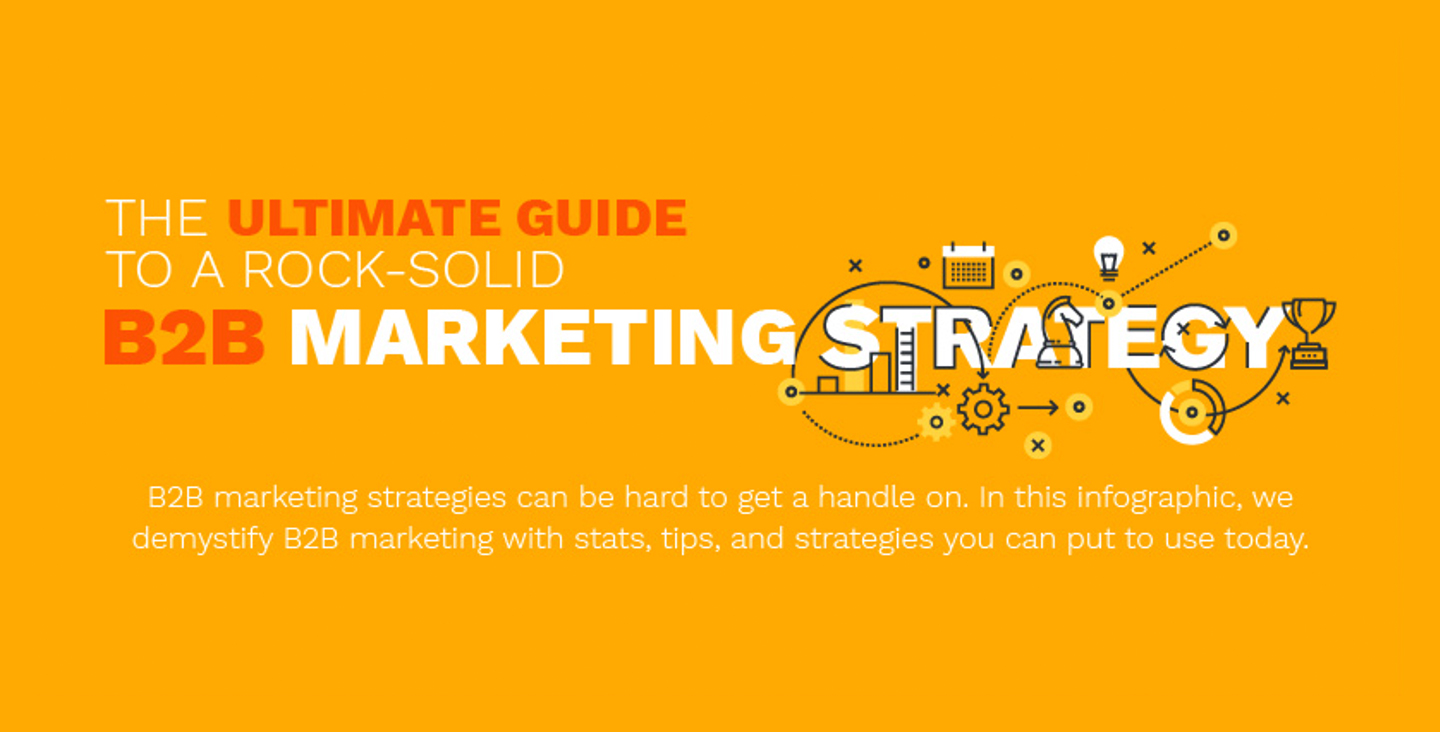Imaginasium | Marketing Communications | 10 minute read
15 B2B Marketing Strategies to Drive Sales
A Smart B2B Marketing Plan Makes All the Difference
Sometimes there’s talk about B2B marketing as though it were something foreign or different from other kinds of marketing. It can sound like an impenetrable cloud of secrets, mysteries and insider knowledge.
Truth be told, thinking about B2B marketing as a mythical creature of the marketing world can do more harm than good — this is how a lot of manufacturers and other B2B companies find themselves with frustratingly bad websites and outdated marketing practices. The world has changed around them, largely driven by the consumer experience, and they haven’t caught up.
So let’s look at 15 top B2B marketing strategies that should be on your radar – why they’re necessary and how to make them work for you.
Start With Understanding

Do you really know your customers? And, just as importantly, do they feel it?
All the strategies in the world won’t help you succeed at B2B marketing unless your customers grasp that you understand their pain points, their opportunities, their potential – and bring value into those spaces. Far too often, the real value of working with a company gets lost in specs, technical terms, and industry jargon. Mounds of information, under which so many manufacturing marketers bury themselves.
Begin every B2B marketing effort with a clear sense of the benefit that you bring your customers’ lives. And a concise articulation of what you do and why it matters (from their perspective).
Strategy #1: Go from Understanding to Branding
By now, most companies understand that your brand is not your logo. Or your name. Or your colors and fonts and signage, koozies and baseball caps.
It’s the sum total of every touchpoint that you have with your customers. Every single experience a person has with your company – good or bad, planned or unplanned, inside your walls or out in the market. Your brand is everything a person knows about you and how it makes them feel. It’s the whole perception of you as a company that someone forms in their mind based on every time they’ve heard of you, seen you, or interacted with you.
So when we talk about developing a B2B brand, we’re talking about getting intentional about the experience you offer your customers. That means thinking long and hard about who you really are as a company and why you do what you do. In particular, it means figuring out how to communicate that experience in a way your customers will understand. Not just intellectually, but emotionally. A strong brand is one that grabs people by the heart and doesn’t let go.
But I don’t mean emotional as in “we need a video about gearboxes that makes me cry like I’m watching a Pixar movie.” I mean emotional as in it gets me, knows what I care about, and shows me why life will be better if I choose you.
That’s what a brand (and its communication and marketing) should do. Connect. Especially in B2B marketing.

[Infographic] A Quick Positioning Statement
We’re often asked to help create positioning statements that serve as the backbone of marketing strategy. The best formula that we have come up with in the past 30 years is:
We want to change A (a challenge)
For B customers (a persona)
By means of C (a strategy)
With D result (a picture of the future state).
Part two of setting the table for success? Translating your understanding of customers into actionable insights.
Strategy #2: Mix Traditional and Digital Tactics

Now that you have a sense of positioning – the message to the right people – you’re ready to create a strategy to carry that message to the world – at the right time, and through the right channels.
This is a place where B2B companies often get tripped up, where those “How it’s always been done” issues rear their heads. Another pitfall? The latest and greatest technology or tool is seen as a cure-all. Fact is, you don’t have to choose between so-called old fashioned practices and the latest shiny digital trend. There can still be room for cold calls, in-person meetings, sales sheets, direct mail, and handshakes, as well as robust, tech-savvy digital implementations.
Strategy #3: Dealer/ Distributor Marketing
If you rely on dealer or distributor networks, you know that it can be tough to market to these groups. In some ways, they’re like customers; in others they’re like employees. In any case, they’re representing your brand to the world – and that’s not something you want to leave to chance, or even leave to those same old brochures and sell sheets. Here’s an approach to consider:
1. Start by understanding what’s important to them, just like you do with customers. What’s keeping them up at night?
2. Understand the kind of support they need to be successful in their own business.
3. Show them what’s in it for them – why you do what you do and how you’ll help them make their customers’ lives better.
4. Help them understand you, the same way you’d want your employees to understand you. Make sure they know what you stand for, what you value and how you do business. Make sure they know what you expect of anyone representing your brand.
Ultimately, building strong partnerships with your dealers and distributors is 1. Through clear, consistent communication and 2. By equipping them with the tools they need to build their own reputations. Not just product information and spec sheets, but the kind of messaging that can get them on board with your brand and what it stands for.
Strategy #4: B2B Referral Marketing
Word-of-mouth is still the most effective kind of marketing. According to Edelman Trust Barometer, 84% of B2B decision-makers begin the buying process based on a referral. Happy customers (or even non-customers who hold you in high regard) who recommend you to their peers are worth their weight in gold.
But if you really want to cash in on the power of referrals, you can’t just sit and wait for them to happen. The more intentional you are about empowering customers to do your selling for you, the better.
Building a referral strategy makes sure that your happiest customers have easy ways to advocate for you. Put simply:
1. Give your customers the kind of experience they’ll want to talk about
2. Give them the tools to easily refer others to you
3. Stay in communication every step of the way.
Asking for referrals is a remarkable test of alignment, between who you think you are and what your customers are experience from your brand. It shows you where there are gaps—which means you’ll not only get the benefit of referrals, you’ll also be able to continuously refine the experience you offer.
Strategy #5: Trade Show Marketing

Trade shows are to B2B sales and marketing what Samuel L. Jackson is to the Marvel Cinematic Universe—an absolute staple. But sometimes trade show participation becomes more about “being seen there” than about “a great opportunity to connect with our customers.”
However, connecting is what trade shows are all about. Make sure you’re not just showing up with some fun giveaways. Go in with a strong story to tell, and bring it to life through every aspect of your trade show presence.
A well-designed booth that invites attendees into conversation. Support materials that clearly communicate your brand, not just your product specs. Staffing your booth with engaging people who buy into your brand and mission and can embody the personality and experience you offer. Trade shows are an ideal place to show your personality and immerse customers in your brand.
Don't Neglect Digital

You should not ignore digital marketing, any more than you should chase it because it seems like the flavor of the month. Spend the time to learn what makes it work< and how it can best support your business. Then approach it with eyes wide open and create your strategy with intention.
There are many digital tools out there, that can assist your B2B marketing. For a deep dive, Larry Kim at MobileMonkey put together a great roundup of the 15 Best B2B Marketing Tools For Companies Ready to Grow in 2020.
To get you started, though, here are some digital marketing tactics every B2B company should pay serious attention to.
Strategy #6: An Awesome B2B Website
Having a great website is not negotiable. 94% of B2B customers turn to the internet when they’re considering a purchase – and a website can take them 57% of the way through the buying process before they even contact you. By the time you hear from anyone, there’s a good chance they’ve already been researching you, reading reviews, and generally scouring the internet to learn everything they can about their options. Which means that your website should be credible and differentiating. Unfortunately, far too many websites are disappointing, or even just okay.
After all, your B2B customers are consumers, too; their expectations of a great website are shapes by their experiences on Amazon.com, JCrew.com, or even Zappos and Zillow, as much as other B2B sites.
The short version? Take cues from online experiences that connect with a great user experience, clear navigation, a great mobile platform. If your web experience is closer to a great consumer website, you’ll make a great impression and have a serious leg up on most of your competitors.
Strategy #7: A Solid B2B Content Marketing Strategy
Of course, you can’t rely on customers blindly stumbling across your awesome B2B website. You must actively draw them to it. And one of the best ways to do that is to offer plenty of useful, authoritative content, for free, on your website. Content marketing has become a buzzword, but it’s popular because it’s incredibly effective... when it’s done right.
The wrong way? To think that more is better, pumping out content stuffed with keywords just to try to grab Google search results. Google is smarter than that—they know the difference between good quality and bad content.
The right way to do content marketing is quality over quantity.
Yes, quantity is part of the equation. But you must create content that is valuable. The secret sauce of content marketing is not just that it can help people find you, but that once they do find you, they engage with you as an authority. When you establish yourself as a reliable source of truly useful information, you can seriously strengthen relationships with customers.
Strategy #8: B2B Email Marketing
Email is, by far, one of the most effective ways available to reach your customers. It’s direct, it’s personal, and when customers opt-in to hear from you, they’re more likely to take action.
But you can’t do it without a plan. A few things to keep in mind:
1. Make a plan to build your email list. That can mean giving customers the chance to opt in to your newsletter within a blog post (just don’t make it a generic “ask” … be sure to offer them an e-book or something of immediate and substantive value in exchange for their signup). Or asking for business cards at trade shows. Or even buying a list of prospective customer contacts.
2. Create a calendar for email marketing and stick to it. Be consistent. If you say you’ll send a monthly newsletter, don’t miss a month. If you want to send out regular promotions, put them on the calendar and send them on time, every time. People notice if you are or aren’t consistent, and that plays into their perception of what it might be like to work with you.
3. Plan your content. Don’t sit down to write content or choose an article to send the day you’ve got an email going out. Be intentional about what you’re saying, when. Make sure your emails offer real value. The people on your list have opted to receive messaging from you because they believe it will help them. They’re giving you their time. Don’t let them down.
4. Use a good email marketing tool to automate your messaging. There are plenty of good ones out there, like Mailify, Mailchimp, or Constant Contact. The scheduling and marketing automation capabilities you get are well worth it.
Strategy #9: B2B Organic & Paid Search Marketing

92% of internet-searching customers start with Google. So it makes sense to rule the search results. Paid search advertising can be an effective and relatively low cost way to boost your organic search results, and so get onto a customer’s radar during the earliest phases of their research.
This starts with knowing what your customers care about, the problems they’re trying to solve, and the words and phrases they’re using to search for answers. Then you can place ads that respond to those keywords and pop up when your customers search for them on Google.
Focus first on content that solves people’s problems, not just trying to sell them on your products and services right out of the gate. Even for ads. They likely know little to nothing about your brand, so you need to earn their trust before asking for the sale.
Strategy #10: B2B Social Media Marketing
Many manufacturers and other B2B companies set up social media profiles because, well, that’s what people say they should do. Done right, social media can be an important tool for reaching B2B customers, but you need a plan out how to use it.
In other words: posting memes of piano-playing cats is not a useful business strategy.
Sharing thought leadership on LinkedIn might be. Or using Facebook to highlight how involved your employees are in the community (something that can go a long way in gaining your customers’ trust and respect). And so on.
Of all the available social media platforms, LinkedIn, Facebook and Twitter account for 90% of social traffic to B2B blogs and websites. So it pays to be there. Get to know the different social platforms and what they’re good for, plan the content you want to put there, and stick to it.
• LinkedIn B2B marketing. Ideal for sharing useful content with your network, helping to establish you as an authority.
• Facebook B2B marketing. Great for giving customers a glimpse into the personality and values of your company. People want to know if they’ll get along with you and align with what you believe.
• Twitter B2B marketing. Useful for sharing content, giving news and updates, and having direct, one-to-one conversations with customers.
Strategy #11: Display/Banner Advertising and Retargeting
Say that you’re shopping online, looking at lawn mowers. An hour later you open your browser to read the news or check Facebook, and you keep seeing display advertising for those same lawn mowers. And the way that they follow you around the internet? That’s retargeting.
Yes, there are times that it can be annoying or feel invasive. But done well, it’s an effective way to stay top of mind for a customer who’s shown interest in you already but hasn’t taken the next step (email subscription, membership, purchase, etc.).
4 Other B2B Experiential Marketing Strategies

Strategy #12: Display/Banner Advertising and Retargeting
A live, engaging, one-time or traveling experience can make a big impression. Consumer brands often leverage them to create marketing that is fun, thought-provoking, challenging, and educational.
A pop-up event is a great way to bring potential customers into deeper conversation, giving them a chance to learn about or demo products, interact with experts, or even just experience your brand in a totally new or unexpected way.
One great example of this kind of experiential marketing comes from SAP, a B2B software company, and their Fan Energy Zone installation for Super Bowl 50. The Super Bowl is a consumer setting, but it made sense because SAP recognized that this kind of partnership is not only a great way to tell their brand story on Sunday evening, but many of the consumers they reached are also potential B2B customers, come Monday morning.
Events like this are effective because they’re unexpected, memorable, create all sorts of positive brand associations, and generate a lot of word-of-mouth and social sharing.
Strategy #13: Build Your Own Conference

In some ways, this is the live and in-person version of content marketing. Gather a group of industry experts, thought leaders and presenters together; create learning opportunities or workshops; bring in a great keynote speaker; and make the whole kit and kaboodle available as a high-value event for your customers and others in your industry.
You’ll build great contacts and gain a huge boost in credibility as the experts who made it all happen. And it creates all sorts of other opportunities for messaging before, during and after the event—video, supporting ads in trade publications, sponsored content, PR, you name it.
Strategy #14: Design an Engaging Tour
A client of ours once told us, “When we can get a prospect to visit us in person, nine times out of ten they become a customer.” There’s great power in putting faces and personalities to the work you do.
Just think: it might possible to create a version of this in-person experience, online:
• Plan a route.
• Write a script.
• Create tour stops where you can speak to specific aspects of your work and how it helps your customers.
• Let them interact with employees, products or messaging.
• Use your interior space as a canvas to communicate your brand through environmental graphics and design.
• Make your company tour less about show-and-tell and more about connecting with customers through riveting storytelling.
A fantastic company tour is one place where everything you’ve worked to create—a great brand experience inside and out—comes together. Where you can show your customers in no uncertain terms that what you’ve been telling them about yourselves and who you really are, are in full alignment.
And that kind of alignment depends on one very critical thing …
Align Internally and Externally

The majority of the B2B marketing strategies we’ve been talking about have to do with external communication. But your brand can’t come to life for your customers, without the employees who put it into action.
So our final B2B marketing strategy is something you probably wouldn’t even think of as a B2B marketing strategy. But it’s an essential piece of the puzzle.
Strategy #15: Internal Communication and Brand Alignment
Make sure part of your strategy includes a plan for communicating your mission and vision and brand to your own people:
1. Be consistent.
2. Be in constant communication.
3. Point your people to the values you hold dear and the behaviors that make them real for customers.
Nothing else you do will matter for long if your internal team isn’t on board and engaged with the promise you’re making to customers. So be as intentional in communicating your brand internally as you would be externally, because they’re the true keepers of your experience.
One B2B Marketing Strategy to Rule Them All
If there’s a single core truth when it comes to B2B marketing strategy, it’s this: make sure that you are being strategic.
Random, reactive marketing might give you a shot in the arm at the time (sometimes), but in the long run it’s more likely to have the opposite effect—it will absolutely end up damaging the experience you’re trying to create.
Intention, consistency and alignment are the name of the game. Don’t let these various strategies exist in isolation. Everything needs to serve a larger plan. Everything should be focused on a clear set of goals.
And no matter what, make sure every strategy connects your brand and its purpose to your customers.
